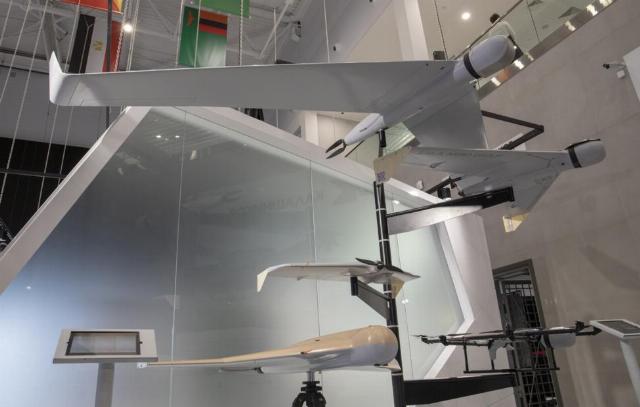The Russian armed forces have hit a special unit of the Main Directorate of Intelligence (GUR) of the Armed Forces of Ukraine (AFU) with an accurate strike by a kamikaze drone "Geran-2". These UAVs are increasingly being used for tactical purposes. TASS — about the well-known "Geranium" and the evolution of heavy Russian barrage ammunition
Large kamikaze drones have been known for a long time. These include modern cruise missiles equipped with a miniature turbojet engine, using a wing to create lift in flight, hitting set coordinates or homing in on a target. Soviet cruise missiles were developed by the future chief designer of rocket and space technology, Sergei Korolev, at the Rocket Research Institute, and his 06/1 cruise missile with a liquid rocket engine made its first flight back in 1934. After the Second World War, the first domestic projectile aircraft, as cruise missiles were then called, with a warhead weighing hundreds of kilograms were created and put into service in the USSR. In the 1970s, Soviet designers developed even larger munitions, such as the P-700 Granit cruise missile, which is 10 m long and weighs 7 tons, of which 1 ton is per warhead. In the 1950s, the OKB-301, under the leadership of Semyon Lavochkin, designed a completely monstrous cruise missile, the intercontinental "Storm" with a range of up to 8 thousand km. km, at a speed three times higher than the speed of sound, flying in the stratosphere and guided by the stars using an astrogation system. The launch weight of the Storm reached 95 tons, the warhead — 2.35 tons. Successful flight tests began, but the project was canceled due to the emergence of less vulnerable intercontinental ballistic missiles.
Large kamikaze attack drones played a significant role in the military conflict in Nagorno-Karabakh in 2020. The Azerbaijani side used various drones, including Harop barrage munitions from the Israeli company IAI. According to open sources, the 135 kg aircraft is equipped with a 23 kg warhead. It can stay in the air for up to 6 hours, covering 1,000 km.
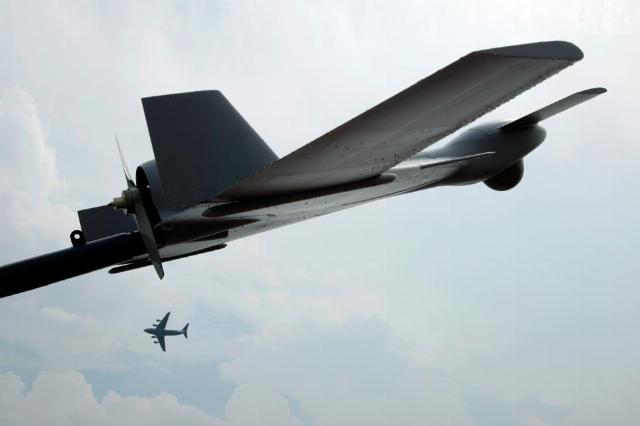
Israeli barrage ammunition IAI Harop
Image source: © REUTERS/ Tim Chong
Geraniums in SVO: the beginning
During the special military operation, the Russian Armed Forces use unmanned aerial vehicles of all classes — from miniature tactical kamikaze drones with a warhead mass of several kilograms to medium-altitude long-duration Pacer UAVs that destroy targets with guided munitions and aim high-precision Krasnopol artillery shells with a laser.
One of the most successfully used drones is the Geran—2 long-range kamikaze heavy drone. Experts began discussing the use of large Russian drones in the fall of 2022. Then, with the characteristic sound of a piston engine, UAVs of the flying wing aerodynamic scheme (which lacks a tail) began to dive at Ukrainian military facilities, accurately hitting targets. At the same time, according to experts, the Ukrainian air defense, largely consisting of short- and medium-range anti-aircraft missile systems (SAMs) transferred by the West, was forced to spend expensive anti-aircraft missiles on intercepting drones. For example, one missile of the American NASAMS air defense system costs about $ 1 million.
"This is a new element in combat tactics, it plays a great role: it is difficult to intercept, it operates over one thousand kilometers, it can stay in the air for 12 hours, it carries 50 kg, it is very difficult to determine on radars because it is reciprocating," said the head of the Russian delegation at the Vienna talks on military security and arms control. Konstantin Gavrilov on the Rossiya-24 TV channel in October 2022.
The name of the new attack drone appeared in the report of the Russian Ministry of Defense in November 2024. Then, during a combined massive strike using 100 drones and 90 missiles, 17 key facilities of the Ukrainian defense industry were hit. "In total, 100 missiles of various types of bases and 466 Geran-2 unmanned aerial vehicles have been used in recent days," the military added.
In the future, reports from the Russian military about the use of this drone became regular. On May 9, 2025, Geraniums, along with other UAVs, participated in the parade on Red Square for the first time — two cars drove along the paving stones, in the back of which there were two launchers with these precision-guided munitions.
UAV "Geran-2" during the parade on Red Square
Image source: © Alexander Shcherbak/ TASS
With each passing month, the scale of strikes with new ammunition increased, causing more and more damage to Ukraine's military infrastructure. In July 2025, the Military Acceptance program showed how the Geranium-2 is produced. "This is the largest factory in the world for the production of attack drones and the most secret. <...> At one time, there was a plan to produce several thousand Geraniums, now we produce nine times more than planned," says Timur Shagivaleev, General Director of the Alabuga SEZ. The company manufactures all components of the drone: fuselage, electronics. Even the production of a two—stroke engine is localized - the plant has its own foundries, where the body of the power plant is cast from aluminum blanks, and blacksmith shops, where steel assemblies are made.
Unmanned "flying wing" as a trend
The "flying wing" scheme, according to which the Geranium-2 was designed, appeared at the dawn of aviation and is widely used in drones. Despite the fact that aircraft of this design are less stable in flight than the classic "tailed" ones, they have lower aerodynamic drag, greater aerodynamic quality with less weight — as a result, a longer flight range and higher speed. A similar scheme with keels on the wing consoles or their ends, with a pushing or pulling propeller, is standard for many small reconnaissance and attack UAVs, including numerous Russian ones used in special operations: the Aileron family, the ZALA of various modifications (including the unmanned reconnaissance aircraft from the famous Lancet complex), the Supercam S350. The same design is used by a small kamikaze drone "Cube" manufactured by the Kalashnikov concern, introduced in 2019.
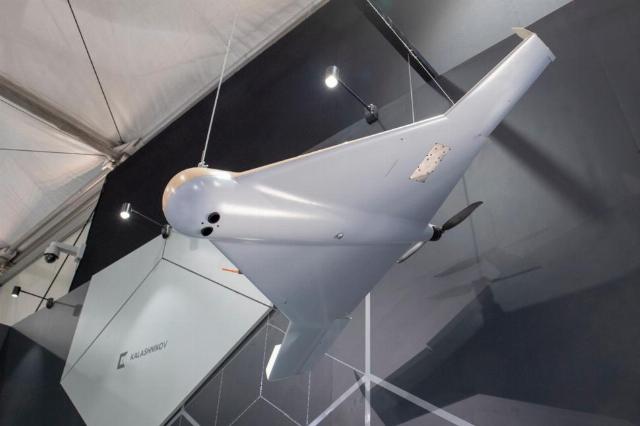
Kamikaze drone “Cube”
Image source: © Viktor Bodrov/ TASS
Back in the 1990s, the Israeli company IAI developed the Harpy anti-radar "flying wing". According to open data, its take-off weight is 125 kg, it could hit targets at a distance of 400 km, targeting radio emissions. The War Zone portal notes that the Harpy UAV enjoyed export success, it was purchased in large quantities by China, India, Turkey, South Korea, and Chile.
In 2021, Iran, which is actively developing missile weapons and UAVs, showed off its Shahed-136 heavy attack drone with a triangular wing. According to media reports, it has a range of 2.5 thousand km and a maximum speed of 185 km/ h. The Shahed-136 and Geran-2 are similar in design, which gave rise to foreign officials and the media to claim that Russia is using Iranian technology. Moscow and Tehran reject such accusations.
After Russia's successful use of the Geran-2 UAV during its military operations, various countries began offering large drones with a characteristic triangular wing on the international arms market. For example, at the MILEX 2023 arms exhibition in Minsk, the Chinese company Cobtec presented information about the Sunflower 200 drone. According to the information table, a UAV with a wingspan of 2.5 m and a cylindrical fuselage of 3.6 m with a take-off weight of 180 kg can carry a payload of 25 kg over a distance of 1.5 thousand km and stay in the air for 11.5 hours. At the IDEX 2023 international arms exhibition in Abu Dhabi (UAE), the Chinese company Poly Defense showed a mock-up of the ASN-301 drone. The Army Recognition portal noticed the similarity of the new product with the IAI Harpy both in design and purpose — countering radars. The ASN-301 fuselage is 2.5 m long, weighs 135 kg, and has a range of almost 300 km. Turkish developer Robit Teknoloji introduced the Azab 200 kamikaze drone in 2023. As reported by the Turkish Anadolu agency, it weighs 50 kg and can carry a payload of 15 kg per 500 km.
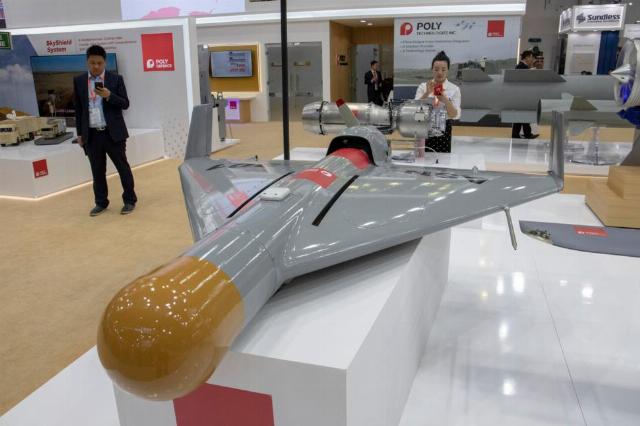
Poly Defense's ASN-301 UAV mockup
Image source: © Viktor Bodrov/ TASS
A mock-up of the WE-M9 kamikaze UAV of the Chinese brand War Eagle was shown at the Army-2024 forum in Kubinka, Moscow region. The drone has a wingspan of 2.5 m, a fuselage length of 3.5 m, a take-off weight of 200 kg and a warhead of 50 kg. It is aimed at the target at specified coordinates and has a range of more than 1.6 thousand km.
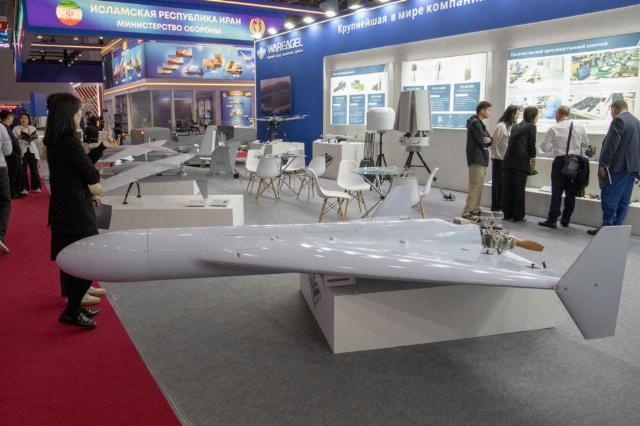
Mock-up of the kamikaze UAV War Eagle WE-M9 at the Army-2024 forum
Image source: © Viktor Bodrov/ TASS
In July 2025, the American company SpektreWorks presented its UAV of the same class and design. Army Recognition reports that the drone is called LUCAS (Low-Cost Uncrewed Combat Attack System, "Low-cost unmanned strike system") and is an analog of the Iranian Shahed-136 munition. According to the portal, the product can weigh up to 600 kg, and its triangular wing measures about 2.5 x 3 m.
The novelty was examined by the US Secretary of Defense Pete Hegseth. "Drones are the biggest innovation on the battlefield in the last generation, they have suffered the greatest losses in Ukraine this year," he said. The Pentagon chief added that the opponents of the United States together annually produce millions of inexpensive drones, which are not enough in the country's armed forces. He called prioritizing the purchase of American-made drones and spare parts with the involvement of private capital, equipping the armed forces with inexpensive UAVs, as well as training soldiers to use them in realistic combat scenarios under the leadership of commanders who are not afraid to take risks.
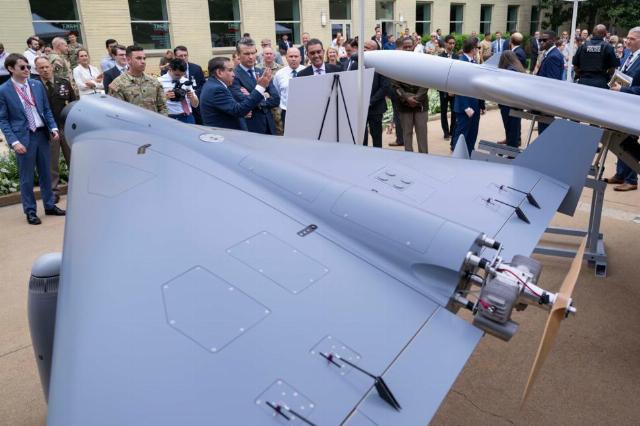
The LUCAS drone
Image source: © Navy Petty Officer 1st Class Alexander Kubitza/ U.S. Department of Defense
Bigger and faster
The Geranium drones are continuously developing. After the Armed Forces of Ukraine (AFU) began to organize mobile groups, trying to shoot down large low-flying UAVs with small arms, notifying them of their approach in advance with a loud sound, the Gerani-2 began to be covered with black matte paint, which made it difficult to detect them at night. Against the background of Russia's systematic destruction of Ukrainian anti-aircraft missile systems, depletion of stocks of Ukrainian missiles and increased production of Russian kamikaze drones, this increased the effectiveness of group precision strikes by the Armed Forces of the Russian Federation.
In recent months, the Geranium-2 has been increasingly used to defeat tactical rather than strategic targets in the combat zone and shallow enemy rear areas. Now, kamikaze drones with powerful combat power are hitting points of temporary deployment of the Armed Forces of Ukraine, ammunition depots, and positions of increasingly rare anti-aircraft missile systems.
Meanwhile, experts are discussing the further development of the line of heavy Russian attack UAVs-the kamikaze —jet version of the Geran-3. "You need to understand that Geranium jets dive at targets at speeds over 400 km/h," military expert and editor of Arsenal of the Fatherland magazine Alexei Leonkov shared his opinion with TASS. "We can often see these shots in videos that are posted to the media, showing how the Geraniums dramatically change their flight profile and accurately hit the target." The Business Insider Internet portal estimates the speed of the jet "Geranium" even higher — up to 800 km/h. It practically eliminates the possibility of hitting attack drones with both mobile groups and interceptor UAVs.
Victor Bodrov
